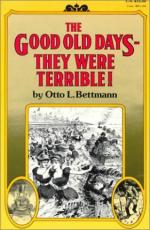
|
| Name: _________________________ | Period: ___________________ |
This test consists of 15 multiple choice questions and 5 short answer questions.
Multiple Choice Questions
1. What was "swill" milk?
(a) Milk from goats.
(b) Milk from cows that were fed waste.
(c) Milk that was used for medicinal purposes.
(d) Milk that had gone bad.
2. What was the primary cause of surgical deaths after the Civil War?
(a) Lack of anesthesia.
(b) Ineptitude.
(c) Heart attack.
(d) Infection.
3. How did people know when a ship in the late 19th century was infected with disease?
(a) The captain ran ashore with the news.
(b) The ship radioed ahead.
(c) The ship flew a yellow flag.
(d) The ship came into the harbor but did not anchor.
4. What was blamed for the cholera epidemic in 1832?
(a) Vegetables.
(b) Unsanitary restaurants.
(c) Unclean water.
(d) Tainted Meat.
5. The diet of the average American in the late 19th century was:
(a) Vegetarian.
(b) Highly varied.
(c) Mostly Italian.
(d) Far from healthful.
6. According to Bettmann in "Food and Drink," what percentage of people in prison were alcoholics?
(a) 60%.
(b) 30%.
(c) 45%.
(d) 50%.
7. According to Bettmann in "Crime," what higher-level organizations were just as corrupted as the police?
(a) City politics.
(b) FBI.
(c) SWAT.
(d) The senate.
8. How did the gun laws after the Civil War compound the problem?
(a) The laws enabled known criminals to carry weapons.
(b) Only the frontier lawmen were allowed to carry guns.
(c) There were no real gun laws.
(d) The waiting period was too short to buy a weapon.
9. How could travel in the Victorian period be defined?
(a) Slow.
(b) Dangerous.
(c) Quick and easy.
(d) Exciting.
10. What was "bogus butter"?
(a) Margarine.
(b) Butter that the poor ate.
(c) Butter that was made from mashed potatoes, bleach or hog fat.
(d) Butter that was made from swill milk.
11. According to Bettmann in "Travel," what was often the result of an open-window train car?
(a) Occupants would choke on smoke from the engine.
(b) Passengers would freeze.
(c) Passengers suffered from insect bites.
(d) Passengers were crime victims at railway stations.
12. What could the Pullman sleeping car in the late 19th century be compared to?
(a) Sleeping in a sardine can.
(b) Sleeping in a cattle car.
(c) Sleeping standing up.
(d) The luxuries of an ocean liner.
13. How were the boilers a danger to the ferries according to Bettmann in "Travel"?
(a) The aged boilers would simply blow up.
(b) They overheated.
(c) They broke down constantly.
(d) They often started fires on board the ferries.
14. Disease and sickness on the ocean liners caused them to be nicknamed:
(a) "Dead man's ships."
(b) "Funeral ships."
(c) "Floating coffins."
(d) "Hospital ships."
15. Which part of the population got to enjoy the luxuries of ocean liners in the late 19th century?
(a) Immigrants.
(b) Foreign dignitaries.
(c) The rich.
(d) Politicians.
Short Answer Questions
1. How did parents in the late 1800s react to teachers using necessary classroom discipline?
2. How were medical advances defined during the Victorian period?
3. The "protection" and "non-harassment" fees of the police in the late 19th century were a precursor to what later crime force?
4. When was opium introduced?
5. What prognosis did alcoholism usually carry in the late 19th century?
|
This section contains 527 words (approx. 2 pages at 300 words per page) |

|




